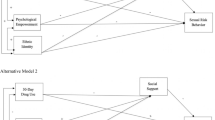Abstract
This study investigates sexual risk behavior among a national sample of Black adolescents. While risky behavior among black adolescents has been studied, many studies are limited methodologically, and are not sufficiently focused on family factors. Using data from the National Longitudinal Study of Adolescent Health, findings indicate that there is a substantial overlap in risky behaviors among black adolescents, in that sexual behavior is strongly related to substance use. Family factors play a role in sexual behavior among black adolescents, in that maternal warmth is associated with less involvement in sexual behavior. The impact of peer drug use, family structure and religious involvement is of limited significance in sexual behavior. These results differ from previous research. We interpret the results and make suggestions for future research on black adolescent sexual behavior.
Similar content being viewed by others
References
Bearman, P. S., Jones, J., & Udry, J. R. (1997). The National Longitudinal Study of Adolescent Health: Research design. Retrieved from http://www.cpc.unc.edu/addhealth.
Blum, R. W., Beuhring, T., & Rinehart, P. M. (2000). Protecting teens: Beyond race, income, and family structure. Minneapolis, MN: Center for Adolescent Health, University of Minnesota.
Clawson, C. L., & Reese-Weber, M. (2003). The amount and timing of parent–adolescent sexual communication as predictors of late adolescent sexual risk-taking behaviors. The Journal of Sex Research, 40, 256–264.
Cooper, M. L. (2002). Alcohol use and risky sexual behavior among college students and youth: Evaluating the evidence. Journal of Studies on Alcohol, (Suppl 14), 101–117.
Cooper, M. L., Pierce, R. S., & Huselid, R. F. (1994). Substance use and sexual risk taking among black adolescents and white adolescents. Health Psychology, 13, 251–262.
Davis, E. C., & Friel, L. V. (2001). Adolescent sexuality: Disentangling the effects of family structure and family context. Journal of Marriage and the Family, 63, 669.
Deleire, T., & Kalil, A. (2002). Good things come in threes: Single-parent multigenerational family structure and adolescent adjustment. Demography, 39, 393.
French, D. C., & Dishion, T. J. (2003). Predictors of early initiation of sexual intercourse among high-risk adolescents. Journal of Early Adolescence, 23, 295–315.
Hirschi, T. (1969). Causes of delinquency. Berkeley: University of California Press.
Hogan, D. P., & Kitagawa, E. M. (1985). The impact of social status, family structure, and neighborhood on the fertility of black adolescents. American Journal of Sociology, 90, 825–855.
Hollander, D. (2003). Teenage women who are devoted to their religion have reduced sexual risk. Perspectives on Sexual and Reproductive Health, 35, 107.
Lanctot, N., & Smith, C. A. (2001). Sexual activity, pregnancy, and deviance in a representative urban sample of African American girls. Journal of Youth and Adolescence, 30, 349–372.
Lefkowitz, E. S., Boone, T. L., Sigman, M., & Au, T. K.-f. (2002). He said, she said: Gender differences in mother–adolescent conversations about sexuality. Journal of Research on Adolescence, 12, 217–242.
Mandara, J., Murray, C. B., & Bangi, A. K. (2003). Predictors of African American adolescent sexual activity: An ecological framework. Journal of Black Psychology, 29, 337–356.
Manning, W. D., & Lamb, K. A. (2003). Adolescent well-being in cohabiting, married, and single-parent families. Journal of Marriage and Family, 65, 876.
Maxwell, K. A. (2002). Friends: The role of peer influence across adolescent risk behaviors. Journal of Youth and Adolescence, 31, 267–277.
Miller, K. S., Forehand, R., & Kotchick, B. A. (2000). Adolescent sexual behavior in two ethnic minority groups: A multisystem perspective. Adolescence, 35, 313–333.
Newcomer, S., & Udry, J. (1984). Mothers’ influence on the sexual behavior of their teenage children. Journal of Marriage and the Family, 46, 477–485.
Regnerus, M. D. (2003). Linked lives, faith, and behavior: Intergenerational religious influence on adolescent delinquency. Journal for the Scientific Study of Religion, 42, 189–203.
Rosenthal, D. A., Smith, A. M. A., & de Visser, R. (1999). Personal and social factors influencing age at first sexual intercourse. Archives of Sexual Behavior, 28, 319–333.
Santelli, J. S., Lowry, R., Brener, N. D., & Leah, R. (2000). The association of sexual behaviors with socioeconomic status, family structure, and race/ethnicity among US adolescents. American Journal of Public Health, 90, 1582–1588.
Smetana, J. G., Crean, H. F., & Daddis, C. (2002). Family processes and problem behaviors in middle-class African American adolescents. Journal of Research on Adolescence, 12, 275–304.
Tapert, S. F., Aarons, G. A., Sedlar, G. R., & Brown, S. A. (2001). Adolescent substance use and sexual risk-taking behavior. Journal of Adolescent Health, 28, 181–189.
Valois, R. F., Oeltmann, J. E., Waller, J., & Hussey, J. R. (1999). Relationship between number of sexual intercourse partners and selected health risk behaviors among public high school adolescents. Journal of Adolescent Health, 25, 328–335.
Wallace, J. M. Jr., & Forman, T. A. (1998). Religion’s role in promoting health and reducing risk among American youth. Health Education & Behavior, 25, 721–741.
Wu, L. L., & Thomson, E. (2001). Race differences in family experience and early sexual initiation: Dynamic models of family structure and family change. Journal of Marriage and Family, 63, 682–696.
Acknowledgement
This research uses data from Add Health, a program project designed by J. Richard Udry, Peter S. Bearman, and Kathleen Mullan Harris, and funded by a grant P01-HD31921 from the National Institute of Child Health and Human Development, with cooperative funding from 17 other agencies. Special acknowledgment is due Ronald R. Rindfuss and Barbara Entwisle for assistance in the original design. Persons interested in obtaining data files from Add Health should contact Add Health, Carolina Population Center, 123 W. Franklin Street, Chapel Hill, NC 27516-2524. This research was supported by a grant from the National Institute on Drug Abuse (DA14672).
Author information
Authors and Affiliations
Corresponding author
Rights and permissions
About this article
Cite this article
Broman, C.L. Sexual Risk Behavior Among Black Adolescents. J Afr Am St 11, 180–188 (2007). https://doi.org/10.1007/s12111-007-9020-7
Published:
Issue Date:
DOI: https://doi.org/10.1007/s12111-007-9020-7




